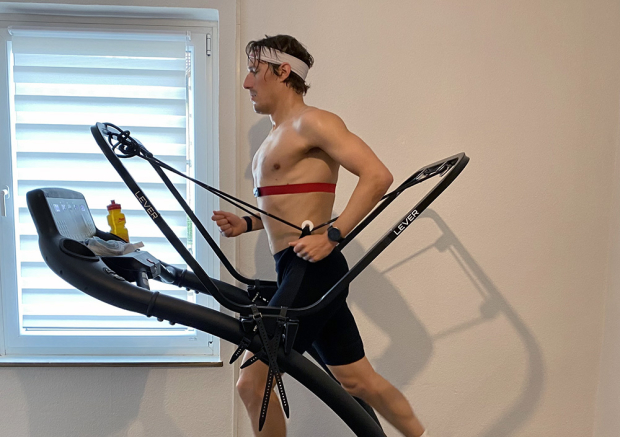I spotted the Lever Running device a couple months ago on the Instagram page of Sebastian Kienle. The fast and very popular German had been plagued with an Achilles injury and used this Boulder, Colorado based technology to train with a lighter load while injured.

“It’s a quite genius idea. We tried to do something similar ourselves, but it never really worked that well,” said Kienle in a subsequent Slowtwitch interview when I asked him about it. “It’s made by a small company from the US named Lever. I usually run with about 85-95% of my bodyweight. I just use a scale to adjust the system. I usually use it once or twice a week. Either to just get an extra session in without putting too much extra strain on my Achilles or to be able to run faster with a lower HR. It’s easy to travel with, so it also helps in training camps. I also found it quite helpful to run with a good technique after I restarted training because you often start to change your natural running technique, if you have pain. By reducing the impact to the amount where I don’t feel pain, I’m able to build back confidence.”
I also then noticed various other professional triathletes such as Matt Hanson, Paula Findlay and Flora Duffy on various social media channels on treadmills in action with that Lever Running device and got me interested to get one for myself. Most athletes are familiar with the AlterG anti-gravity treadmill which allows the user to reduce the body weight from 100% to 20% in 1% increments. The AlterG though is not a unit typically found in the home of an athlete, but in sports rehab facilities. Depending on the model the AlterG costs between $35,000 and $75,000 and isn’t very portable. So clearly that was not an option for me and I thus pulled the trigger on the Lever Running system. With my reasonably narrow waist it was a size M, and that is the size of the neoprene shorts. The aluminum frame is the same size for all.

The Lever Running system costs $1099 and for that money you get the Lever Running frame, the Lever neoprene shorts with the built-in rollers, and a transport bag. In 5-pound increments it is possible to reduce your weight by up to 45 pounds, and in my case of 181 pounds that would mean I could run as light as 136 pounds and finally run like a Kenyan. The unit is very portable and could easily accompany an athlete to an event or could be taken and set up at a local gym. According to Lever Running it is meant for treadmills with arms parallel to the running belt and fits 28-36" treadmill arm widths. Woodway arms are not parallel but Lever Running offers a 3d printed adapter for those popular treadmills, and those adapters cost $99.
I did not want the device because of an injury, but my weekly training volume was very high, and had been so for the last 18 months. In addition to big cycling and swimming numbers, I had logged 4000 running miles in 2020, and almost 2000 running miles in the first half of 2021. My plan was to use the Lever Running system to take some load off my body during some of my heavier weeks. The package arrived in early June just before my Black Mountain Monster 6-hour race and as luck would have it I soon after did indeed get injured with a patella stress fracture. I however managed to get in a few sessions before the injury and then was able to use the Lever Running unit just like Seb Kienle as I tried to take it easy and get healthy again. Once I was able to put some load on the knee I mostly ran or power walked on the treadmill with a reduced weight of 15-30 pounds. I however rarely have pushed it all the way to 45 pounds. Not because it isn’t useful, but because you can feel the difference much sooner. Basically a large aluminum frame that sits on the arms of the treadmill suspends an athlete on that treadmill, and in order to make that happen the athlete needs to wear specific Lever Running neoprene shorts. A thick elastic cord runs through built-in rollers on each side of the neoprene shorts and at the base of these shorts are wide integrated velcro straps that allow the athlete to tighten the shorts on the legs to prevent a possible wedgie.

The CamLock device allows the athlete to determine how much weight he or she wants to take off. Silver markings on the elastic cord that suspends the athlete indicate 5 pound increments. But with a scale the adjustment can be done more accurately.

Up front on the other side of the aluminum frame the elastic cord starts with a simple carabiner, and from there goes to the roller on the right side of the neoprene shorts and then goes to the back of the aluminum frame. And yes that is an image of Sebastian Kienle on the wall of my nirvana space.

The back of the aluminum frame has two simple rollers that allow the elastic cord to move.

This is a closer look at the 3d printed adapter for the Woodway 4Front treadmill. Basically held in place with 4 straps total on each side, and I added silicone strips at the base to hold it even more securely since I am heavier than the pros I mentioned earlier.

Once through the back two rollers the elastic cord then runs through the left side roller on the shorts and then goes to the CamLock.
The setup is easy and straight forward, and once the frame is attached to the treadmill getting the elastic cord in place is super fast, and the same thing is true with getting out of that suspended position should one have to run to the bathroom or otherwise needing to get off the mill.
I can now run again without the Lever Running device but I will keep it in place and use it still regularly. As of now I still have to take it easy anyhow to prevent injuring myself again, but even when fully healthy I can see the benefit of running with a reduced load. So this system is a keeper and gets a big thumbs up.
It however brings up a possible ethical dilemma. What about racing on the treadmill with such a device? For me the answer is quite simple - this Lever Running device will only be used for training and training runs. Plus I have not really planned any virtual races anytime in the near future. Should that scenario however come up, I will refrain. Hopefully other athletes who have this system or something similar will also put morals over ego.
Image 1 © Sebastian Kienle
Images 2-7 © Herbert Krabel
My nirvana cave is sadly too narrow to get a nice side shot of the Lever Running device, thus I used the image that inspired me in the first place. Thank you Sebi for the inspiration and the pic.



